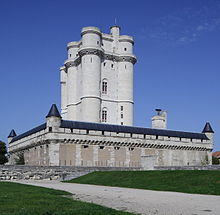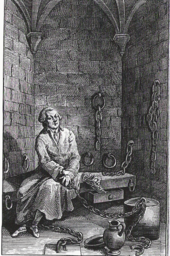State prison in the donjon of Vincennes
The state prison in the Donjon of Vincennes existed in the Ancien Régime until April 1784. In the 19th century, the rooms of the Donjon, east of Paris, were only used sporadically as a prison .
The donjon
The 50-meter-high, Gothic four-tower donjon once served as the residence of the first Valois kings. Only under Louis XI. it was used as a prison. Isolated from the rest of the castle by its own curtain wall and a separate moat , it was predestined for this new task. The operation of the prison required only minor structural changes.
While the large central halls also served as cells in the 17th century, in the 18th century only the octagonal lanes of the smaller corner turrets were used for accommodation. In 1808, Napoléon Bonaparte had a prison door and a stove installed from the temple , which can still be seen in the donjon today. In contrast to the other towers, it remained almost intact thanks to its function as a state prison. It is considered to be the most important preserved donjon in France. There were three restoration campaigns , under Eugène Viollet-le-Duc , in 1914 and from 2000 to 2005. Since 1934 it houses a historical museum .
Prisoners of the king
Like the larger Bastille, the Donjon was a royal prison. The state prisoners were detained in the donjon by means of a sealed arrest letter ( lettre de cachet ) signed by the king and minister . Recent research shows that the disreputable royal arrest letters saved some Vincennes inmates from a worse sentence from the judiciary ( parliament ). In the same way, the king could also proclaim an exile to Vincennes.
Well-known prisoners of the Ancien Régimes
The list of prisoners includes famous names such as the writer Claude-Prosper Jolyot de Crébillon , the Jansenist theologian Jean Duvergier de Hauranne , the encyclopedist Denis Diderot , the Cardinal von Retz, Jean-François Paul de Gondi , the Marquis de Sade and the Revolutionary Mirabeau .
Well-known noble inmates were Louis II. De Bourbon, prince de Condé , and his brother François de Bourbon, prince de Conti , who suffered the same fate as their father Henri II. De Bourbon, prince de Condé , who was also imprisoned there. Even the name of the escape king François de Vendôme , the Duke of Beaufort, cannot be separated from Vincennes, especially since his father César de Bourbon, duc de Vendôme , was imprisoned in the donjon. Louis XIV had his finance minister Nicolas Fouquet and Antonin Nompar de Caumont , Duke of Lauzun, arrested there. Insane people celebrated as heroes by the French Revolution, such as Latude and Le Prévôt de Beaumont , had their fits of rage, interpreted as “resistance to tyranny” . Victor Riquetti, known as the Physiocrat, was banished for a short time to the nearby castle , opposite the Donjon .
The prison staff
At the head of the prison hierarchy in the 18th century was the royal lieutenant and governor of the donjon, who was subordinate to the police prefect of Paris. For your physical and mental well-being of prisoners were a doctor , a surgeon , a pharmacist , a dentist , an ophthalmologist , a confessor , an Institution spiritual , as well as a kitchen team responsible. In the inner area, three guards were responsible in the donjon, while outside sentries were on duty. A secretary of the police prefect read and censored the letters of the Vincennes prisoners in Paris.
Everyday life in prison at the end of the Ancien Régimes
The Donjon zu Vincennes, which is literarily decried as “hell”, “grave” and “place of horror”, was of a better nature than its reputation. The latest research shows that romantic prison literature , pamphlets and drama- oriented prison memoirs carried by former inmates such as Latude, Le Prévôt de Beaumont or Mirabeau created a myth rather than telling the truth: Compared to the conditions in the The Vincennes inmates had it relatively comfortable in parliamentary prisons and asylums. Despite illness, lack of air, light or warmth, the agony was less of a physical nature, but was mainly based on mental pain. In particular, loneliness, boredom, domestic worries and uncertainty about the release date made life difficult for the prisoners.
The easing of detention or moderation granted for repentance, insight and good behavior such as walks, receiving visits, books, magazines, writing utensils, letters, visits to trade fairs, cellmates or servants could make everyday life easier. In the 18th century, walks were the only physical exercise available. There were no opportunities for manual or physical work in this rather aristocratic prison, so that only writing was possible. The easing of detention could be extended to the point of semi- detention , which ended in exile or release. In the case of bad leadership, relief was withdrawn. In the event of serious violations of the prison rules , such as outbreaks of violence and fits of rage, severe imprisonment could be imposed and the prisoner transferred to a special cell ( French : cachot ). In the case of the insane with a tendency to violence, this measure was imposed as the last wisdom according to the state of knowledge at the time.
Breakouts and attempts to escape
The Castilian nobleman Philippe von Crouy fled the castle in 1556 in the clothes of a peasant. François de Vendôme achieved the most sensational outbreak: on Whitsun 1648 he climbed a rope from the gallery of the Donjon wall into the ditch. On the other side 50 mounted helpers were waiting for the duke. However, the plot forged by the Princes of Condé and Conti and the Duke of Longueville failed. Latude reports in his memoirs of two successful escape attempts in 1750 and 1765.
The lifting of the state prison
At the end of the Ancien Régimes there were only 15 prisoners left in the donjon. On the orders of King Louis XVI. In 1784 the state prison was closed and the guard and the office of governor lifted. The last inmates were transferred to other prisons. In 1785 a bakery and a rifle manufacture moved into the Donjon.
The storm on the donjon

The National Assembly decided in November 1790 by decree to use the Donjon as a prison again because the Paris prisons were overcrowded. The rumor circulated among the Parisian people that they wanted to set up a royalist arsenal there for a counter-revolution. On February 28, 1791, an angry crowd, mostly from the suburb of Saint-Antoine, stormed the empty donjon. The mayor of Vincennes called on the Paris National Guard for help. Commander La Fayette prevented the destruction of the donjon by breaking up the riot with some horsemen and arresting 60 people. The National Assembly decided to abandon their plan.
19th century prisoners
Under Napoleon, the donjon was used as a prison from 1804 to 1814 and during the revolutions of 1830 and 1848 and as a result of the uprising of the Paris Commune in 1872. In 1808 Jules and Armand de Polignac sat in the donjon because they were involved in the Cadoudal and Pichegru conspiracy against Napoleon. The dispute between Napoleon and the Pope in 1811 led to the appointment of numerous clergymen. As a result of the July Revolution , Jules de Polignac came again as a prisoner to Vincennes, where the overthrown ministers Peyronnet , Guernon-Ranville and Chantelauze were already incarcerated. The Republicans Armand Barbès , Louis-Auguste Blanqui and François-Vincent Raspail were arrested in the donjon for participating in the June uprising in Paris in 1848.
literature
- Benno Hägeli: The tyrant tower or prisoner in the donjon of Vincennes. Everyday life in prison at the end of the Ancien Régime. Luzern [2004], 2 volumes.
- Benno Hägeli: The tyrant tower or imprisoned in the donjon of Vincennes. In: Berner Historische Mitteilungen . 2004/2005, pp. 5-26. ( PDF ; 592 KB)
- François Paule-Michel-Jacques-Raymond de Fossa: Le Château historique de Vincennes. H. Daragon, Paris, 1908–1909, 2 volumes.
Web links
- Vincennes Castle
- The donjon of Vincennes Castle as a 3D model in SketchUp's 3D warehouse
Individual evidence
- ↑ chateau-vincennes.fr ( Memento of the original from March 10, 2016 in the Internet Archive ) Info: The archive link was inserted automatically and has not yet been checked. Please check the original and archive link according to the instructions and then remove this notice. , Accessed January 6, 2010.
Coordinates: 48 ° 50 ′ 33.5 " N , 2 ° 26 ′ 4.8" E

